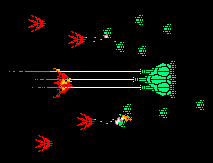Combat Between the Weak and Strong
May 28, 2016 | View Comments | |
The Game
This is a simple game, part of my early investigations into maths and games.
There are two opposing armies with weak and strong troops. Each turn, the armies simultaneously deal damage to one another. The game ends when one or both sides are destroyed.
An army deals 1 point of damage for each weak troop it has, and 3 points for each strong one. Every 3 points of damage an army suffers, one of its troops are destroyed. Weak troops are destroyed before strong troops.
Let’s watch a battle between two armies of spaceships (why not?). One army has a strong ship and 5 weak ships. The other has just 5 weak ships…

In the first turn, the red army deals 8 damage, destroying 2 ships with 2 damage left over. The blue army deals 5 damage, destroying 1 ship with 2 damage left over…

In the second turn, the red army deals 7 damage. Combined with the 2 damage left over from last turn, this is enough to destroy 3 ships. The blue army is destroyed, but not before it deals 3 damage and destroys another ship…

Comparison of Troops
If an army of strong troops fights an army of weak troops, it turns out a strong troop is twice as valuable as a weak one. The following armies are evenly matched:

In the first turn, the red army destroys 1 ship with 3 damage. The blue army only deals 2 damage…

In the second turn, both armies are destroyed.
Composition of Armies
It turns out armies are stronger with a mixture of troops. If we assume strong troops are twice as valuable as weak ones, 2 strong and 8 weak are worth as much as 12 weak or 6 strong. However, in practise:
| Setup | Result |
|---|---|
 |
 |
 |
 |
In the mixed army, strong troops deal damage more efficiently (being 3 times more destructive but only twice as costly), but weak troops absorb damage from the enemy (being less valuable and more disposable).
Hence, despite the simplicity of this game, it is interesting strategically. If armies fought more than one battle, things would be more interesting still… the armies would need more weak troops (to stay mixed after successive battles), the ideal amount being determined by how many battles they take part in.
Other Findings
Interestingly, with armies equal in value to 12 weak troops, the strongest army consists of 1 strong and 10 weak troops. Exactly why this proportion is ideal needs more investigation.
It seems an army of 2 strong and 8 weak is better than 3 strong and 6 weak (as you’d expect, being closer to the ideal proportion):
| Setup | Result |
|---|---|
 |
 |
 |
 |
 |
 |
 |
 |
The army with 2 strong and 8 weak is generally better off at the end of each battle. The army with 3 strong and 6 weak usually deals more damage than it needs to.
What is unexpected is that the 2⁄8 army and the 3⁄6 army are, against each other, evenly matched. The mechanics behind this need further investigation too. Observe:

After the first turn:

After the second turn:

At this point, the armies are in the same position. The battle will be a perfect draw.
comments powered by Disqus